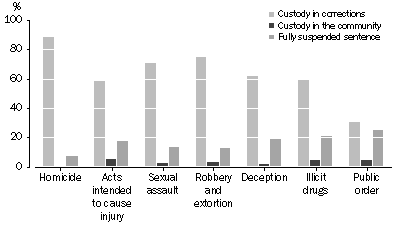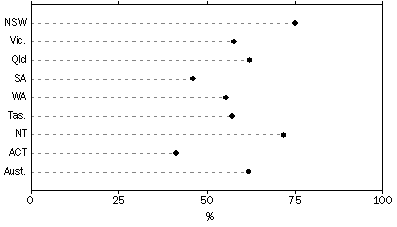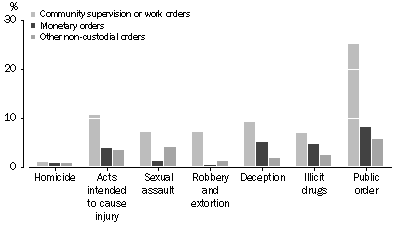SENTENCE OUTCOMES
The following information relates to sentence outcomes for defendants heard in the Higher Courts. Defendants are referred to as 'convicted' where they were proven guilty of at least one of the final charges laid against them. Sentence refers to the principal sentence a defendant received (refer to Explanatory Notes paragraphs 46-48 for further information).
Differences in sentencing are a result of the offence the defendant was convicted of, as well as a range of aggravating and mitigating factors taken into account by the court, such as prior convictions, level of violence, whether the offender was provoked, and demonstrations of remorse.
Custodial orders
The majority (83% or 11,005) of defendants proven guilty in 2007-08 received a custodial order. This proportion increased over the 7 years from 2001-02 when it was 72%. Of defendants proven guilty, 74% were sentenced to custody in a correctional institution; 5% to custody in the community; and 21% were granted fully suspended sentences. Defendants sentenced to custody in a correctional institution increased from 58% of custodial penalties in 2006-07.
The proportion of convicted defendants who received a custodial sentence in a correctional institution ranged from 31% for public order offences to 75% for robbery and extortion, and 89% for homicide. Defendants convicted of public order offences were more likely to receive a fully suspended sentence (25%) than defendants with most other offences.
DEFENDANTS PROVEN GUILTY, Selected principal offence by custodial sentence

A greater proportion of males proven guilty received a sentence of custody in a correctional institution or the community than females (64% compared with 47%). A larger proportion of convicted females were given fully suspended sentences than males (23% and 16% respectively).
The proportion of defendants proven guilty receiving a custodial sentence in a correctional institution varied across states and territories, ranging from 41% in the Australian Capital Territory to 75% in New South Wales.
DEFENDANTS PROVEN GUILTY, Custody in corrections by states and territories

Non-custodial orders
Defendants sentenced to non-custodial orders (community supervision or work orders, monetary orders and other non-custodial orders) accounted for 17% (2,200) of defendants proven guilty in the Higher Courts.
Community supervision or work orders were issued to: a quarter (25%) of defendants convicted of public order offences; 11% of those convicted of acts intended to cause injury; and 9% of those convicted of deception. A greater proportion of defendants convicted of public order offences (8%) received monetary orders than defendants convicted of other offences.
DEFENDANTS PROVEN GUILTY, Selected principal offence by non-custodial sentence

The proportion of convicted females receiving community supervision or work orders (17%) is almost double the proportion of males (9%). A larger proportion of both male and female convicted defendants under 25 years of age received a non-custodial order (16% and 24% respectively), compared with other age groups.
 Print Page
Print Page
 Print All
Print All